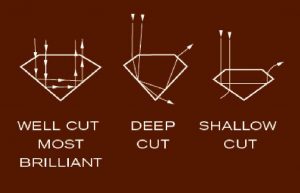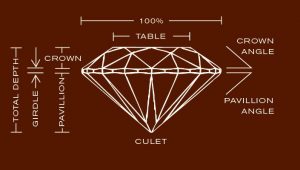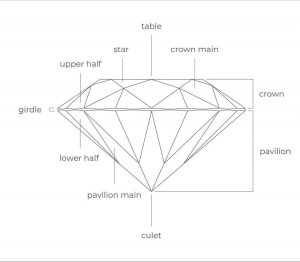Cut Grading

The Importance of Diamond Cut: A Craftsmanship-Dependent Property
The cut of a diamond is the only factor entirely shaped by human craftsmanship. It goes beyond just the shape and style of the diamond, encompassing its proportions, symmetry, and overall finish. A diamond’s cut directly influences its brilliance, sparkle, and overall beauty, making it a critical factor in determining its value. Skilled craftsmanship ensures that the diamond’s facets are precisely arranged to maximize light reflection, enhancing its fire and brilliance. When selecting a diamond, prioritize cut quality, as it is key to unlocking the diamond’s full visual potential.
Proportions

Maximizing Diamond Brilliance: The Importance of Proportions and Angles
The cut of a diamond is crucial in determining its brilliance and fire, which refers to its sparkle and brightness. Proportions and angles play a key role in how light is reflected within the diamond and dispersed as it exits. This directly impacts the diamond’s perceived beauty, making cut one of the most important factors to consider when purchasing a diamond.
A diamond can be cut for either maximum weight recovery or maximum brilliance, but there’s always a trade-off. While poorly cut diamonds may sell at a discount in the trade, unsuspecting retail customers may end up paying the same price regardless of the quality of the cut.
For round brilliant diamonds, there are several optimal cuts, each with slightly different proportions based on scientific formulas designed to maximize light reflection. However, the final choice often depends on the buyer’s taste and preference for the diamond’s appearance.
Key Facets of a Round Brilliant Cut Diamond:
- Table – The largest, flat facet on the top of the diamond, allowing light to enter and exit. It’s the primary entry point for light that influences the diamond’s brilliance.
- Crown – The crown features several facets running from the table to the girdle. These facets refract and reflect light, enhancing the diamond’s brilliance and fire.
- Pavilion – Located on the bottom half of the diamond, the pavilion’s facets reflect light back up towards the crown, maximizing brilliance.
- Girdle – The girdle is the widest part of the diamond, connecting the crown and pavilion. It serves as the diamond’s perimeter and supports the facets.
- Culet – A small facet at the base of the diamond, where the pavilion facets meet. Its purpose is to prevent chipping and enhance the durability of the diamond.
These facets are carefully cut and arranged to optimize the flow of light through the diamond, resulting in the renowned brilliance and fire. The quality of the cut, combined with the other 4 Cs—carat weight, color, and clarity—determines the overall beauty and value of the diamond.
When choosing a diamond, always consider the cut quality, as it has a significant impact on how the diamond interacts with light, ultimately defining its sparkle and visual appeal.

